| 1 | 2 |
|
Wide angle attachments in pictures and diagrams |
Here are some simple diagrams showing what is meant by barrel and pincushion distortion. This should be fairly obvious, but let me know if it isn't and I'll elaborate.
 |
 |
 |
No distortion |
Barrel Distortion |
Pincushion distortion |
Other Defects that matter
Flare is often increased or exaggerated by bad barrel design and lack of good blackening of the ground edges of the elements. Astigmatism is the smearing of detail towards the edges of the frame. This is caused by bad design, low precision or completely inappropriate matching of lens and converter.
A certain degree of all of these defects is unavoidable in the design of a consumer wide-angle or telephoto lens attachment.
Examples
When viewing the following images, make sure you compare them to what the Sony's own lens does all on its own.... from my PC110 review, here are a couple of images showing the amount of distortion already created by this lens.
 <click to open> Barrel Distortion at short focal lengths. |
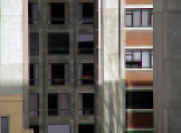 <click to open> Pincushion distortion at long focal lengths |
Both of the above images show unacceptable levels of distortion if they had been taken on a 35mm SLR camera. We are talking about video gear though and the Carl Zeiss designed lens on the PC110 tends to be highly rated in reviews. Just goes to show doesn't it...
Now for some results from the converters I tried out.
I was not able to test any of these extensively. The main thing I did was take a quick snap of something with horizontal and vertical lines near the edge of the frame. That is why we're usually looking at shelving here.
Click on the images to open a larger version separately
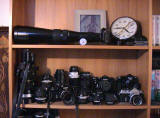 Sony lens at widest setting |
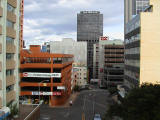 Sony again at widest setting |
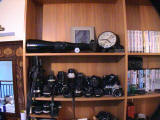 Yashica 0.6x |
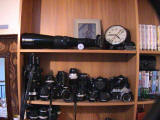 Itorex 0.7x |
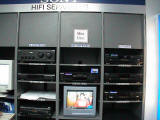 Sony VCLMHG07 |
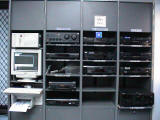 Sony VCLHG0737 |
And finally here, a couple of snaps of the shop interior taken, one each, with the High Grade Sony lenses to demonstrate what a general snapshot might look like without fixing on straight lines. I've let these two images open at their full original resolution of 1152x864 in your browser so that you can use the scrollbars to examine them in their entirety (just in case your screen is smaller than the image).
Internet Explorer 6.x will display the full image reduced to fit the browser window. Just resize the window as large as you like and the image will grow with it until it reaches full size.
 Sony VCLMHG07 (300Kb) |
 Sony VCLHG0737 (300Kb) |
So what do I think about all this?
Straight off the bat, only one lens makes any effort to keep distortion low and that is in fact the Sony VCL HG 0737. From my very rough trials here, I can deduce that this attachment only minimally increases the already obvious, but run-of-the-mill distortion created by the Carl Zeiss lens of the PC110 camera.
In fact, I'd go so far as to suggest that if the Sony's own lens did not distort so much, then the use of the converter would not at all be obvious in the images. If the Sony's own lens were able to go wider by default, it might have performed much like it does with this converter attached.
I am a bit wary of some smearing with
this lens. The final snapshot above shows it (fuzzy) bottom right.
Have a look at the DVDs on the shelf in that area. Another shot that
I haven't displayed here also shows somewhat more smearing in this area than around the
other three corners of the image.
This could well have been a defective
lens. However, to produce that sort of result, the glass would have to be
asymmetrically ground (highly unlikely), badly mounted, or the lens would
have to not be sitting perfectly parallel to the camera's own lens.
I'd have to do some controlled and tripod-mounted outdoor shots to be able
to determine the cause, but it's too late now.. that lens is sold.
All of the attachments show a degree of this smearing though. What makes it really obvious is when it is not evenly spread around all corners of the frame, and with that particular Sony lens, it wasn't. If I ever decide to purchase one of these, I will definitely be trying it out in the shop before I hand over my money.
The large and flat "High Grade" VCL MHG 07 lens is impressive looking and very expensive, but does not appear to perform all that well. It does have good overall sharpness though.
There are also one or two "cheap" Sony add-on lenses about that I have not checked out. I would not expect any of these to perform better than the Itorex seeing as that already performs about as well as the far more expensive lens mentioned in the previous paragraph. If that level of performance is sufficient and digging around second-hand bins is not to your liking, do consider trying out a VCL 0637H if you have a 37mm Sony lens thread.
In the meantime, I've decided to keep the Itorex as my main wide angle attachment. It gives a decent enough result when doing general shots and cost all of a glass of beer. I should point out that Itorex is not a brand of any note. It probably doesn't even exist any more. I merely included that lens and the Yashica to show that one does not have to stay with the manufacturer's own products when it comes to purchasing this sort of item. If you feel like looking for something second-hand, a rule of thumb is: The larger the front element, the less distortion the lens will create.
Conclusion
As far as I can see, there are only two lenses to choose from.
The top-of-the-line Sony VCL HG 0737 is the one to get if you have money left over from your camera.
Everything else is second choice and bargains are to be had in many a junk bin.
Please comment on this article in the Forum
Further Information from around the Web:
A selection of attachments commented on and rated.
This chap would like you to use an image editor to correct the distortion. Good luck.
| 1 | 2 |